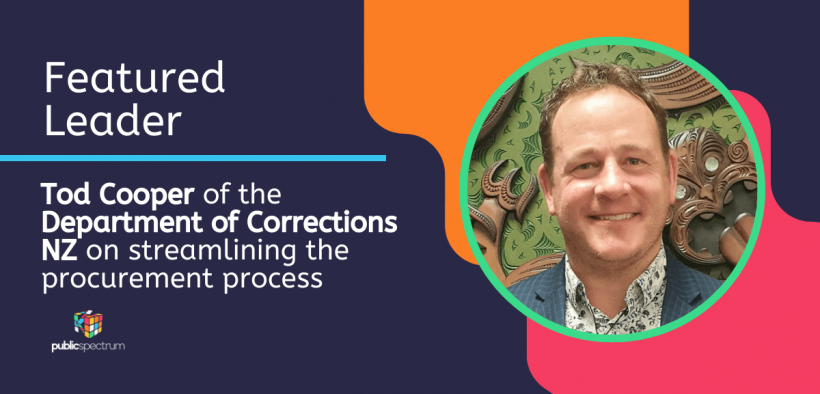Tod Cooper of the Department of Corrections NZ on streamlining the procurement process
Share

Procurement professionals are no strangers to challenges when it comes to their job. And with the ever-changing nature of procurement forcing leaders to innovate and adapt in order to keep pace, the need to modernise one’s procurement process as quickly as possible has become necessary.
Public Spectrum has caught up with Tod Cooper, the Director Procurement of the Department of Corrections NZ, to discuss how procurement officers can streamline their organisation’s procurement process.
A commercial and operational executive, as well as having held leadership and advisory roles over the past 20 years, Tod Cooper is a senior leader with a proven record of building and nurturing high-performing teams and developing organisational growth specifically around commercial maturity and capability.
Tod has navigated both public and private sectors in both sales, procurement and business leadership and development, cementing himself as a key trusted adviser.
He is also the current A/NZ MemComm representative for CIPS, Board Director for Transparency International, and long-standing Regional Business Awards judge
Learn more about streamlining your procurement process by joining us at the Future of Gov Procurement Summit where Tod will be speaking.
What are the usual pain points you’ve experienced when it comes to procurement?
There are three examples that have come to my mind when it comes to pain points within procurement:
Be relevant not the elephant.
As procurement is a reasonably new profession, we have struggled to stand out as a clear value-add business function. This has led to us being fragmented or orphaned in the structure.
Often our capability is dispersed thinly across the business, and investment in procurement, therefore, becomes an afterthought. This has meant we are often ignored, or the last to be brought ‘to the table’. We need to build our mandate and solidify our position as a trusted adviser!
The Tortoise and the Hare.
While not a roadblock, we have historically been a killjoy; “no you can’t do that, you need to do this,” cue overly convoluted process that will take half of the eternity.
This reminds me of one of Aesop’s Fables where we adopt the tortoise approach i.e. slow and steady, which will inevitably keep the business safe, but does mean we miss opportunities for the best outcomes.
Slow and steady might have been fine 10+ years ago, but in today’s rapidly changing world velocity is critical for survival.
Lack of a conveyer belt.
For what is a very well-paid promising career, our tertiary institutions (AUS and NZ) seem to be very slow at jumping on the bandwagon in terms of procurement as a dedicated part of their curriculum.
It is extremely hard to find good talent, and even harder to retain it.
As the Director of Procurement for the Department of Corrections NZ, what were your methods for optimizing the organization’s procurement process?
We are working hard to ‘make it easy for the customer to do the right thing’, but a good process is only as good as the customer’s willingness to adopt it. So much of our process improvement is driven around bringing things back to ‘the right level of simple’.
We are taking a much more principles-based approach to how we procure regardless of whether it is traditional procurement activity or social sector commissioning.
I have introduced a business partnering model and changed the culture of the team away from compliance, and towards ‘doing the right thing’ (whilst being safe).
Can you provide any tools or strategies that other professionals can use to improve their approach to acquiring goods/services?
Don’t streamline or shortcut the front end too much. We need more consultation and co-design, not less. We have all heard the expression ‘two ears, one mouth’. Well, we also have two feet, so use them to get out and engage the supply market well in advance and do it lots. Focus on identifying and targeting suppliers that are capable of high innovation generation, that will shape your design thinking, that will challenge your understanding of what good looks like.
Flip the narrative, define the outcome and work backwards. What does good look like? Take the time to explain why you think the chosen approach delivers the outcomes and contributes to achieving the organisational objectives, and don’t lose sight of how you might measure success.
One should also take a principled approach as it is more subjective and situational than rules, policies, and procedures, so apply your ‘top two inches’ before reaching for the 100-page procurement manual and rule book.
For tools there are heaps, I like to use the old and trusted Supplier Preferencing model to understand how the supply market will see us. This significantly shapes the go-to-market strategy and helps define the level of complexity of the procurement activity.
What are the things that procurement professionals should keep in mind when streamlining their procurement?
First & foremost, procurement professionals should never lose sight of the needs of the customer (both internal & external). They should be the ‘Go Show’, not the ‘No Show’. If a part of a process doesn’t add value, and there are little to no consequences of not doing it, then stop doing it! No one likes inefficiency!
Another thing that they should keep in mind is that they should make it easy for the business to do the right thing, as well as include continuous improvement and innovation in their team culture by empowering and rewarding that kind of behaviour.
Want to gain and share knowledge from other professionals within the industry? Check out our latest public sector events here.
Eliza is a content producer and editor at Public Spectrum. She is an experienced writer on topics related to the government and to the public, as well as stories that uplift and improve the community.











Today’s Pick
11th Annual Aus Goverment Data Summit
April 1, 2025
7th Annual NZ Government Data Summit
May 7, 2025
3rd Public Sector Comms Week
May 14, 2025
Subscribe
We send emails,
but we do not spam
Join our mailing list to be on the front lines of healthcare , get exclusive content, and promos.
AI appointment Australia Australian boost boosts business businesses covid-19 cyber attack cybersecurity cyber security data data breach data management defence Digital employment enhance enhances fraud funding governance government grants Healthcare infrastructure Innovation Lockdown management new zealand NSW NZ online privacy public Public Sector queensland renewable energy scams security Social Media Technology telecommunications victoria
-

Understanding and building your digital strategy
Digital Government, Opinion
-

Featured Leader: Jamie Morse on multi-channel strategies for communication
Communications, Featured Leader
-

Featured Leader: Tegan Tembe of NSW Treasury on creating solid planning strategies and processes
Featured Leader
-

Wirraka Maya Health Service improves patient care with My Health Record
Learning
Show More-

Effects of ineffective communication in the workplace
Communications, Personal Development
-

7 ways you can enhance your personal development skills
News, Personal Development
-

5 advantages of working in the public sector
News, Personal Development, Professional Development
-

7 causes of communication issues in the workplace
Communications, News, Personal Development
Show MoreLast Viewed